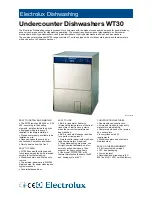
Filling with dishwasher salt
Only use salt specifically designed for use in
dishwashers.
All other types of salt not specifically designed for use in
a dishwasher, especially table salt, will damage the water
softener.
Only fill with salt just before starting one of the complete
washing programmes.
This will prevent any grains of salt or salty water, which
may have been spilt, remaining on the bottom of the
machine for any period of time, which may cause
corrosion.
To fill:
1. Open the door, remove the lower basket and unscrew the
cap of the salt container by turning it anticlockwise.
2. Pour 1 litre of water inside the container (this is necessary
only before filling with salt for the first time).
3. Using the funnel provided,
pour in the salt until the
container is full.
4. Replace the cap making
sure that there is no trace
of salt on the screw
thread or on the gasket.
5. Replace the cap tightly
turning it clockwise until it
stops with a click.
The salt container will require topping up periodically. You are
reminded of this by the salt indicator light on the control panel
which comes on when the salt has finished.
The salt indicator light on the control panel can remain
illuminated for 2-6 hours after the salt has been
replenished, assuming the dishwasher remains switched
on. If you are using salts that take longer to dissolve then
this can take longer. The function of the machine is not
affected.
Do not worry if water overflows from the unit when filling with
salt, this is quite normal.
Rinse aid
Rinse aid is automatically added during the last rinse, ensuring
thorough rinsing, and spot and streak free drying.
The dispenser, which is positioned inside the door, holds about
110 ml of rinse aid, which is sufficient for between16 and 40
dishwashing cycles, depending upon the dosage setting.
Filling with rinse aid
1. Open the container by pressing the release button (A).
2. Add the rinse aid until the container is completely full. The
maximum level for filling is indicated by "max".
Ensure that the lid is closed after every refill.
Clean up any rinse aid spilt during filling with an
absorbent cloth to avoid excess foaming during the next
wash.
Only use branded rinse aid for dishwashers. Never fill the
rinse aid dispenser with any other substances (e.g.
dishwasher cleaning agent, liquid detergent). This would
damage the appliance.
Adjusting the dose
According to the finish and drying results obtained, adjust the
dose of rinse aid by means of the 6 position selector (position
1 minimum dosage, position
6 maximum dosage).
The dose is factory set in
position 4.
Increase the dose if there are
drops of water or lime spots
on the dishes after washing.
Reduce it if there are sticky
whitish streaks on the dishes
or a bluish film on glassware
or knife blades.
Top up the rinse aid when the
indicator (B) becomes clear.
8






































